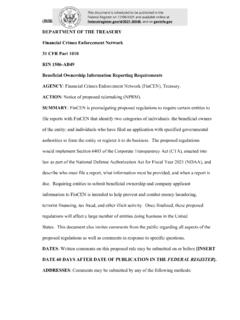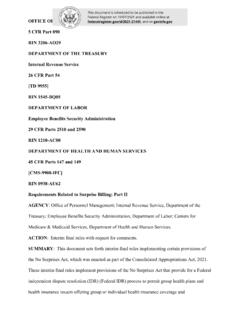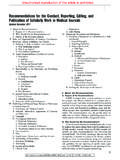Transcription of DEPARTMENT OF THE TREASURY Internal Revenue Service
1 [4830-01-p] DEPARTMENT OF THE TREASURYI nternal Revenue Service 26 CFR Part 1[TD 9930]RIN 1545-BP11 Updated Life Expectancy and Distribution Period Tables Used for Purposes of Determining Minimum Required DistributionsAGENCY: Internal Revenue Service (IRS), : Final : This document sets forth final regulations providing guidance relating to the life expectancy and distribution period tables that are used to calculate required minimum distributions from qualified retirement plans, individual retirement accounts and annuities, and certain other tax-favored employer-provided retirement arrangements. These regulations affect participants, beneficiaries, and plan administrators of these qualified retirement plans and other tax-favored employer-provided retirement arrangements, as well as owners, beneficiaries, trustees and custodians of individual retirement accounts and annuities.
2 DATES: Effective Date: The final regulations contained in this document are effective on [INSERT DATE OF PUBLICATION IN THE FEDERAL REGISTER].Applicability Date: The final regulations in this document apply to distribution calendar years (as defined in (a)(9)-5, Q&A-1(b)), beginning on or after January 1, 2022. FOR FURTHER INFORMATION CONTACT: Arslan Malik or Linda S. F. Marshall, (202) INFORMATION:BackgroundThis document is scheduled to be published in theFederal Register on 11/12/2020 and available online , and document includes amendments to the Income Tax Regulations (26 CFR part 1) under section 401(a)(9) of the Internal Revenue Code (Code) regarding the requirement to take required minimum distributions from qualified trusts.
3 These regulations also apply with respect to the corresponding requirements for individual retirement accounts and annuities (IRAs) described in section 408(a) and (b), and eligible deferred compensation plans under section 457, as well as section 403(a) and 403(b) annuity contracts, custodial accounts, and retirement income Section 401(a)(9) and Related Statutory ProvisionsSection 401(a)(9) provides rules regarding minimum required distributions from qualified retirement plans. These rules ensure that the assets of a qualified retirement plan, which are afforded favorable tax treatment, are used primarily to provide retirement income to a participant, while allowing distributions to continue after the participant s death over the lifetime of the participant s surviving spouse or the life expectancy of certain designated beneficiaries.
4 Accordingly, section 401(a)(9) provides that a qualified retirement plan must commence benefits to an employee no later than a specified age (or within a specified number of years after the employee s death) and, under the regulations, once benefits commence, the pattern of payment must meet certain standards to ensure that distributions are not unduly 401(a)(9)(A) provides rules for distributions during the life of the employee. Section 401(a)(9)(A)(ii) provides that the entire interest of an employee in a qualified retirement plan must be distributed, beginning not later than the employee's required beginning date, in accordance with regulations, over the life of the employee or over the lives of the employee and a designated beneficiary (or over a period not extending beyond the life expectancy of the employee and a designated beneficiary).
5 Section 401(a)(9)(B) provides rules for distributions that are made after the death of the employee. Section 401(a)(9)(B)(i) provides that, if the employee dies after distributions have begun, the employee's interest must be distributed at least as rapidly as under the method used by the employee. Section 401(a)(9)(B)(ii) provides a general rule that the employee s interest must be distributed within 5 years after the death of the employee if the employee dies before distributions have begun. Section 401(a)(9)(B)(iii) provides an exception to this 5-year rule if the employee has appointed a designated beneficiary. Under this exception, the 5-year rule is treated as satisfied if the employee's interest is distributed, in accordance with regulations, over the life or life expectancy of the designated beneficiary, provided that the distributions generally begin no later than 1 year after the date of the employee's In addition, under section 401(a)(9)(B)(iv), if the designated beneficiary is the employee s surviving spouse, the beneficiary may wait until the date the employee would have attained age 72 to begin receiving required minimum 401(a)(9)(C) defines the term required beginning date for employees (other than 5-percent owners and IRA owners)
6 As April 1 of the calendar year following the later of the calendar year in which the employee attains age 72 or the calendar year in which the employee retires. For 5-percent owners and IRA owners, the required beginning date is April 1 of the calendar year following the calendar year in which the employee attains age 72, even if the employee has not 401(a)(9)(D) provides that, except in the case of a life annuity, the life expectancy of an employee and the employee's spouse that is used to determine the period over which payments must be made may be re-determined, but not more frequently than 401(a)(9)(E)(i) provides that the term designated beneficiary means any individual designated as a beneficiary by the employee.
7 Section 401(a)(9)(E)(ii) provides that the term eligible designated beneficiary means any designated beneficiary who is (1) the surviving spouse of the employee; (2) a child of the employee who has 1 However, section 401(a)(9)(H)(ii) provides that, with respect to an eligible retirement plan defined in section 402(c)(8)(B) other than a defined benefit plan, the section 401(a)(9)(B)(iii) exception is only available in the case of an eligible designated beneficiary defined in section 401(a)(9)(E)(ii).not reached the age of majority; (3) disabled within the meaning of section 72(m)(7); (4) an individual who is disabled under section 7702B(c)(2) with a disability of indefinite length which is expected to be lengthy in nature; or (5) an individual who is not more than 10 years younger than the employee.
8 For this purpose, section 401(a)(9)(E)(ii) provides that the determination of whether a designated beneficiary is an eligible designated beneficiary is made as the date of the death of the 401(a)(9)(G) provides that any distribution required to satisfy the incidental death benefit requirement of section 401(a) is a required minimum distribution. The incidental death benefit requirement, which is set forth in (b)(1), provides that although a qualified pension or profit-sharing plan may provide for incidental death (or life insurance) benefits, the plan must be established and maintained primarily for the purpose of providing retirement benefits or deferred 401(a)(9)(H) provides special rules for an eligible retirement plan described in section 402(c)(8)(B) that is not a defined benefit plan.
9 Section 401(a)(9)(H)(i) provides that for such a plan, in the case of a designated beneficiary, section 401(a)(9)(B)(ii) is applied (1) by substituting 10 years for 5 years, and (2) without regard to whether distributions have begun prior to an employee s death. Section 401(a)(9)(H)(ii) provides that the section 401(a)(9)(B)(iii) exception to section 401(a)(9)(B)(ii), as modified, only applies in the case of an eligible designated beneficiary. Section 401(a)(9)(H)(iii) provides that if an eligible designated beneficiary dies prior to the distribution of the employee s entire interest, the remaining interest must be distributed within 10 years after the death of the eligible designated beneficiary.
10 Under sections 403(b)(10), 408(a)(6), 408(b), and 457(d)(2), requirements similar to the requirements of section 401(a)(9) apply to a number of types of retirement arrangements other than qualified retirement plans. However, pursuant to sections 408A(a) and (c)(5), those rules apply to a Roth IRA only after the death of the IRA Pursuant to sections 403(a)(1) and 404(a)(2), qualified annuity plans also must comply with the requirements of section 401(a)(9). II. Regulations under Section 401(a)(9) Sections (a)(9)-1 through (a)(9)-8 provide rules regarding the application of section 401(a)(9).3 In the case of a defined contribution plan, (a)(9)-5 provides generally that an individual s required minimum distribution for a distribution calendar year is determined by dividing the individual s account balance determined under (a)(9)-5, Q&A-3, by the applicable distribution period.
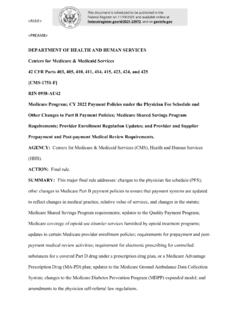
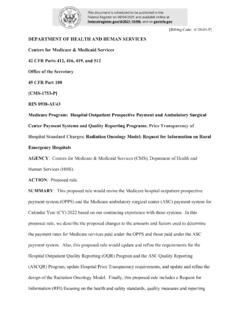
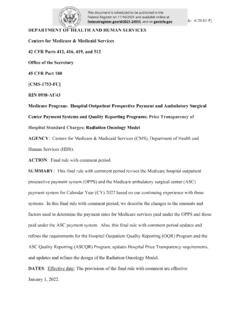
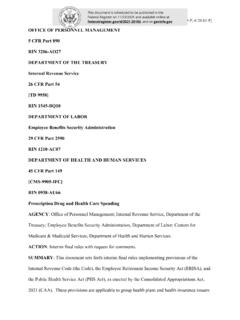

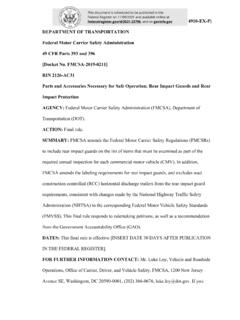
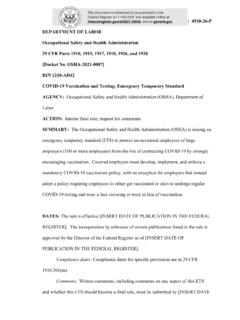
![DEPARTMENT OF COMMERCE [Docket No. 211213-0259] …](/cache/preview/2/2/6/7/7/8/1/2/thumb-22677812e7ac1183a3a0b47ebea8a362.jpg)
